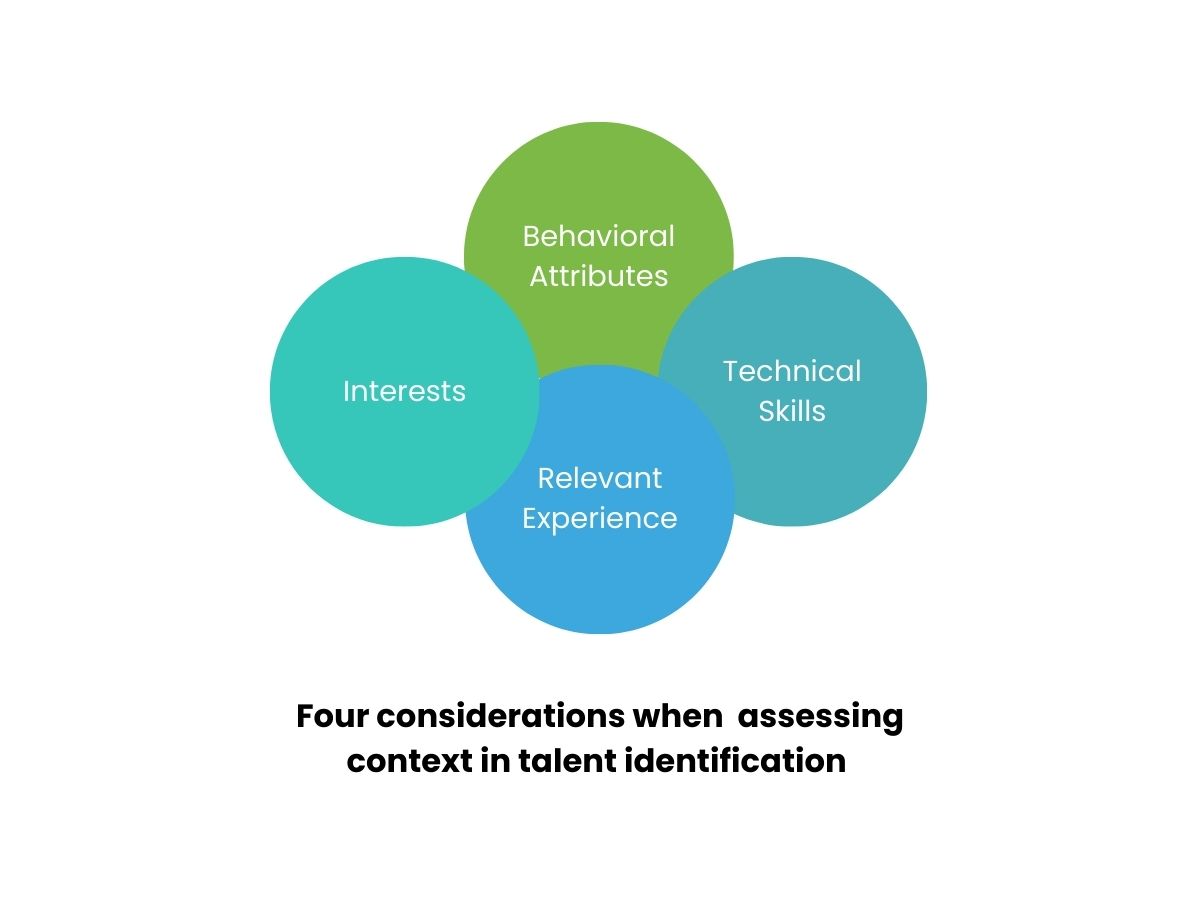Talent identification in most companies is narrowly focussed on pinpointing the skills, capabilities and potential of their top talent. Unfortunately, this approach can result in investing in the wrong people, or putting top talent in the wrong roles.
Talent identification in our opinion is much broader. It is the process of accurately identifying a person’s behavioral strengths, depth of technical knowledge, relevant career experience and personal interests and how those attributes allow them to be more or less successful in a specific context.
In this article we cover how to get fast, accurate answers to the typical ‘who’ questions business leaders ask about their top talent.
View all articles in the series
This is part one in a series of articles about "Answering the Question of Who."
What is talent identification?
The term “talented” is often used to describe people, but it commonly lacks context. You may be talented in a very specific area of HR because of your skills or experience, but you may not be very talented in finance or sales.
When we talk about identifying talent, we are talking about the fit between a person and context they are operating in.
Everyone operates better in a particular context. The role of HR is to maximize the fit, because both the person and the context in which they operate is constantly changing.
The 'who' questions that need to be answered when developing a talent identification strategy
Business leaders typically ask the ‘who’ questions when it comes to talent, and HR is expected to deliver these answers as the custodians of the ‘who’ questions. Here are some of the most common ‘who’ questions about talent identification:
- Who should we hire? Who has the skills, experience and attributes to be effective in this position?
- Who are our high potentials and future leaders? Who can we develop to do something they aren’t currently doing?
- Who has scarce skills or emerging skills that will help us adapt in the future?
- Who are our high potentials? Who could successfully transition to a more complex level of work faster than the average person?
All of these questions have one common thread: The need to identify if a person’s talent and the requirements of the role (i.e. the context) are a good fit.
How to identify top talent quickly and accurately
The aim of this series of articles is to help you to build a capability that allows you to answer the ‘who’ questions faster and more accurately than the business leaders asking them.
Everyone has an opinion, and most talent decisions are based off of opinion. But to be respected, you need facts…fast.
There are four enablers that will help you build the capability to answer questions about your business’ talent quickly and accurately:
Good quality data
One of the biggest challenges to speed and accuracy in decision-making, is quality data. Unfortunately people data is usually not accurate, complete, up-to-date and/or accessible. However, the starting point is knowing what data is relevant.
If we had to ask you what data you need to make people decisions, you will probably ask for as many data points as possible. Think about managing these multiple data points for a minute. If you have 100 people and 100 data inputs, that’s 10,000 data points to manage. Cutting the list of data inputs down to just 15 or 20 would make managing this data over time much easier. The question you should be asking is:
What is the least amount of data we NEED to answer the most important 'who' questions we have to identify our top talent and the businesses requirements?


Efficient processes
The eye-roll is the most common reaction HR get in response to asking employees to complete “people stuff” like talent assessments. Our instinctive response is to weigh up how much time and effort the process is going to take, versus the benefit we get from doing it. If the cost is greater than the benefit, people are not likely to participate. When designing processes we need to ask:
How can we can decrease the cost (time and/or effort) and increase the value (usefulness) that people will get from this process?
Cultural adoption
Bob Sutton is an organizational psychologist and author of The Fiction Project. He believes that if you want people to do something, you need to make it easier to do the right thing, and harder to do the wrong thing. To be clear, the right thing is using an evidence-based approach to talent identification. The wrong thing is guessing and hoping you’re right.
How do we make it easier or faster to get the right answers to the critical 'who' questions?


Embedded technology
The right tools and technology reduce friction in the right areas. Too often technology increases the burden and under-delivers on the result. Technology can end up speeding up, or enabling a dysfunctional result if the first three enablers are not in place.
How do we design technology that it is usable (easy to use) and useful (with high perceived benefits) so that it is used or adopted?
Answering the talent identification 'who' questions
Answering the ‘who’ questions in talent identification requires two data sets.
- Who is the person?
- Who does the person need to be?
Who is the person?
To answer this, begin with the part of the answer that is the most stable. People don’t change very quickly. Traits which are a significant part of someone’s personality, like conscientiousness – which is a Big 5 Personality Trait – tend to remain relatively constant over time once you’ve done an initial skill evaluation.
What do we really need to know about the person?
Behavioral attributes: We know certain behaviors work better in certain roles. Approachable people are more suited to sales roles, whereas detail-oriented people do well in finance. Behavioral attributes can be observed and we all have a different combination of effective and ineffective behaviors.
Technical or functional skills: You can’t work in engineering if you don’t have the knowledge and certifications. Technical proficiency is the price of admission requirement in many roles, and the proficiency level in a technical skill can also vary from beginner to expert.
Experience: We seldom get something right the first time we do it, because as the saying goes, practice makes perfect. We need to know what a person has done so we can compare it to what we are expecting them to do. Experience can be measured by relevance (will it help the person be successful) and depth (have they had enough practice).
Interest: People do better when they are interested in what they are doing or who they are doing it for. Interest fuels the internal motivation engine that makes someone put more discretionary effort into what they are doing.
With these four data points, we can answer almost any ‘who’ question we are asked about talent identification, once we know the context.
Why you need to consider context in talent identification
Think of the context as the job that needs to be done and the conditions under which the person will need to perform. The tasks (work to be done) and work environment (conditions) shape who the person must be.
So to answer the ‘who’ questions, we need to match the person to the context.
What do we really need to know about the context?
We need to know the same things about the context as we do about the person in order to get the right fit, but how we get that information is very different.
Behavioral attributes
Many HR managers make the mistake of asking the business leaders what behavioural attributes are needed to be successful.
If you do this, it undermines your credibility because you should know, but secondly, business leaders don’t know what attributes they are looking for, they only know what success looks like (e.g. a great sales person exceeds their target).
There is a significant amount of research you can leverage to identify the attributes needed for success in different contexts. There are well-researched skills and competency frameworks to help guide you. Use these tools so that you become the authority.
Technical or functional skills
Want to know if someone is good at their job? This is where you ask the manager; it’s their area of expertise. What skills should someone have, at what level of proficiency and why? It’s essential to ask the ‘why’ question to stop over-emphasizing technical skills. Also, keep in mind that higher work levels (e.g. manager versus associate) require greater breadth of knowledge. Technical skills are also seldom the differentiators of high performance, even in highly specialized roles.
Relevant experience
Experience is about practice. Practice can be generalized and relevant experience can be transferred from one context to another. Define types of experiences, not specific ones, and prioritize the high-value ones, i.e. experiences that are difficult to get, e.g. managing a turnaround or integrating a new technology into an existing process.
Interests
What type of people enjoy this type of job? A good example of this is a role that requires an international assignment. Someone might have the attributes, skills and experience but not enjoy being out of their comfort zone or learning about new cultures.

Putting it all together to create a talent identification capability
You’re never going to be able to answer every ‘who’ question quickly and accurately, but you can build the capability to answer the critical ‘who’ questions for your business leaders. Start by compiling your top 10 list of ‘who’ questions that you hear most often, check them with your business leaders and then follow these steps:
Create a data platform
- What data would you need to answer your top 10 questions?
- What do you already have? Where is it? Can it be consolidated into one place?
- What will you still need to get? How can you get it? How will you keep it current? How do you make it accessible to the right people?
Design a process
- Who will you need to get the data from? How often will it need to be updated? How can you incentivize people to give it to you?
- What is the most efficient way of collecting, storing, protecting and maintaining it? If you have more than 50 leaders, Excel is not an effective tool.
- How can you maximize the value of your data by adopting a reuse, reduce and recycle mindset? Can I reuse this data to answer another question? Can I reduce the amount of data I need to answer the question? Can I combine two data points to get a third?
- How will you visualize and present data engagingly and insightfully to get people talking? How can you capture those conversations to increase the data you have?
- How can you create a cadence/rhythm to keep talking about people throughout the year? How do you integrate those conversations into your talent planning process? How do these conversations support your business planning processes?
Create a culture of evidence-based conversations and decision-making
- Who needs to talk about who, what, and when? How do you have respectful conversations about people?
- How do you build the skills in your HR team to provide evidence-based support to business leaders? How do you train your line managers to ask the right questions and respect the right answers?
- How do you make it hard to go with opinions over evidence? How do you make it easy for business leaders to get the evidence they need to answer their who questions?
Scale with technology
- What is the best way to use technology to scale the right processes, collect the right data and facilitate the right conversations?
- How can technology increase access to the right answers throughout the organization? How do you make it a consumer experience rather than an HR one?
- How do you embed upgradeable technology at a reasonable cost? How do you access the skills to manage the technology without increasing your headcount? What is the business case for buying or building your technology solution?
Final note
We started this article with ‘who’ questions related to talent identification because they are the ones we hear business leaders ask most often.
To answer the critical who questions, you need to build a capability that allows you to do it faster and more accurately than business leaders can themselves.
There are four enablers to building this capability: Data quality, process efficiency, cultural adoption and scaleable technology.
There are a number of questions you need to ask before setting off on this journey, and like with most trips, a prepared traveller is a happier one.
Find out more about our approach to helping our clients build the capability to answer their critical who questions.
When you get the answers to your ‘who’ questions right, the result is a healthy, thriving People Ecosystem. Take our People Ecosystem Health Check to find out how healthy your business’ talent is. View our video series on the topic of creating People Ecosystems here.






